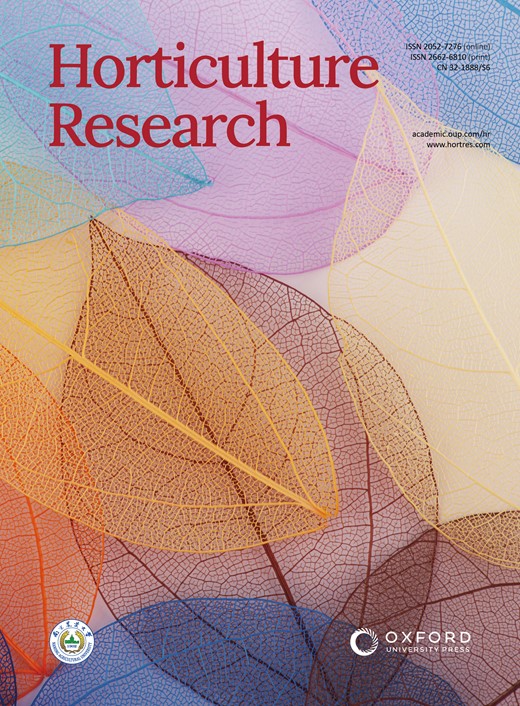The Cytological Mechanism of the Peach Haploid Producing Triploid Offspring
IF 8.7
1区 农林科学
Q1 Agricultural and Biological Sciences
引用次数: 0
Abstract
Peach is one of the most economically valuable fruit trees. Haploid peach trees occur spontaneously at very low frequencies and they are usually highly sterile. Therefore, the haploid with partial fertility is extremely rare germplasm, which is highly valuable to genetic research and breeding programmes. In this study, we investigated the cytological mechanism underlying the fertility of a peach haploid mutant ‘9-D’ derived from a spontaneous mutation. Cytologic evaluation and flow cytometry analysis demonstrated that ‘9-D’ is a pure haploid. Scanning electron microscope analysis revealed a considerable proportion of abnormal pollen grains in ‘9-D’. Pollen viability assay by Alexander staining showed that 50.4% of pollen grains from ‘9-D’ were viable. However, the pollen germination assay showed that only 7.6% of the pollen grains could germinate normally. Investigation of the chromosomal behavior of pollen mother cells at different stages of meiosis showed that pollen mother cells of ‘9-D’ lacked the process between anaphase I and prophase II of meiosis. Various types of sporophyte morphology were observed in haploid pollen mother cells at the tetrad stage. Measurement of the diameter of pollen grains indicated the presence of pollen with 2x ploidy in ‘9-D’. The offspring of ‘9-D’ were predominantly triploid or triploid aneuploid. The triploid offspring were more likely derived from the 2x male gametophyte combined with the haploid female gametophyte, which may explain the reason why ‘9-D’ has fertility. This study not only expands our understanding of haploid fertility mechanisms, but is also useful for ploid breeding programs in peach.桃单倍体产生三倍体后代的细胞学机制
桃子是最具经济价值的果树之一。单倍体桃树自发出现的频率很低,而且通常高度不育。因此,具有部分生育力的单倍体是极其稀有的种质资源,对遗传研究和育种计划具有极高的价值。在本研究中,我们研究了自发突变产生的桃单倍体突变体'9-D'生育力的细胞学机制。细胞学评估和流式细胞仪分析表明,"9-D "是一个纯合子。扫描电子显微镜分析表明,'9-D'中有相当比例的异常花粉粒。通过亚历山大染色法进行的花粉活力测定显示,'9-D'中有 50.4% 的花粉粒具有活力。然而,花粉发芽测定显示,只有 7.6% 的花粉粒能正常发芽。对花粉母细胞在减数分裂不同阶段染色体行为的研究表明,'9-D'的花粉母细胞缺乏减数分裂无丝分裂期 I 和减数分裂原期 II 之间的过程。在四分体阶段的单倍体花粉母细胞中观察到了各种孢子体形态。花粉粒直径的测量结果表明,'9-D'的花粉具有 2 倍体。9-D'的后代主要是三倍体或三倍体非整倍体。三倍体后代更有可能来自 2 倍体雄性配子体与单倍体雌性配子体的结合,这或许可以解释'9-D'具有繁殖力的原因。这项研究不仅拓展了我们对单倍体育性机制的认识,而且对桃的多倍体育种计划也很有帮助。
本文章由计算机程序翻译,如有差异,请以英文原文为准。
求助全文
约1分钟内获得全文
求助全文
来源期刊

Horticulture Research
Biochemistry, Genetics and Molecular Biology-Biochemistry
CiteScore
11.20
自引率
6.90%
发文量
367
审稿时长
20 weeks
期刊介绍:
Horticulture Research, an open access journal affiliated with Nanjing Agricultural University, has achieved the prestigious ranking of number one in the Horticulture category of the Journal Citation Reports ™ from Clarivate, 2022. As a leading publication in the field, the journal is dedicated to disseminating original research articles, comprehensive reviews, insightful perspectives, thought-provoking comments, and valuable correspondence articles and letters to the editor. Its scope encompasses all vital aspects of horticultural plants and disciplines, such as biotechnology, breeding, cellular and molecular biology, evolution, genetics, inter-species interactions, physiology, and the origination and domestication of crops.
 求助内容:
求助内容: 应助结果提醒方式:
应助结果提醒方式:


